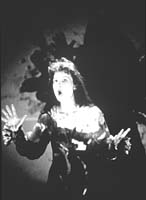

Decided ambivalence seemed to be the reigning attitude in response to Karen Finley's lecture Wednesday night in King. The talk, essentially an oral autobiography illustrated with slides, provided a first-person overview of Finley's controversial role as an artist and social commentator.
Finley began the talk with a personal anecdote, noting, "The first man I lived with went to Oberlin." She then launched into an account of her childhood, recalling her early introduction to the realms of artistic and political awareness, the latter of which occurred when, at the age of twelve, she watched television coverage of police beating protesters at the Democratic National Convention in Chicago.

These parallel artistic and social interests came together in the convictions which Finley refined as a student at the San Francisco Art Institute: not satisfied to work within the tradition of structure-oriented modern art, she decided, "As a female, I had to make something that was content-based."
In her early work, Finley dealt particularly with gender issues and the class disparity involved in the object-oriented visual arts, in which the artist must rely on a wealthy patron or gallery for funding. To avoid this dilemma, she performed on street corners and in nightclubs, focusing on "creating something that was meaningful to the culture at that moment."
These performances evolved into full-length theatrical works, eventually leading to the controversy from which Finley gained her greatest fame and notoriety. In a solo performance entitled We Keep Our Victims Ready, Finley dealt with the case of Tawana Brawley, a 15-year-old girl found in a trash bag, smeared with feces. Finley received funding from the National Endowment for the Arts for the work, in which she addressed the issues of abuse and victimization involved in the case.
However, the funding was rescinded due to the graphic nature of the performance, in which Finley smeared herself with chocolate to represent feces, sprinkled herself with alfalfa sprouts to represent sperm, then added candy hearts, representative of the empty apologies and displays of affection which often follow abuse. The performance was often construed erotically, although, according to Finley, "It's about pain, and no one can see that." Finley and four other artists brought suit against the NEA in a case which drew national attention, including comment from Jesse Helms on the Senate floor, but Finley ultimately lost the suit in the Supreme Court last March.
Unfortunately, she only briefly addressed the implications which her case may have for the future of government funding of the arts, focusing instead on its effect on her personal life: "Jesse Helms and I entered into an abusive sexual relation. Even though it was public, I do feel that I was sexually harassed by him."
Finley also discussed and showed slides of her more recent works, including participatory installation works which have dealt with the issues of queer rights and AIDS. Among the more striking of these works was an installation entitled "Written in Sand," in which the floor of a room was covered with sand and attendees were invited to write the names of AIDS victims in the sand and then wipe them away.
In addition to these works, Finley showed some of her more ironic and sarcastic enterprises, including a soon-to-be-published version of Winnie the Pooh featuring explicit sexual references and characters dressed in bondage gear. Finley seemed to be in best form when describing a work in which she placed books featuring established male modern artists under glass and wrote criticism on the glass. At this point in the lecture she began striding around the front of the lecture hall, throwing out taunts such as "Oh, Man Ray, you're so surreal!" in a style reminiscent of a stand-up comic.
In a sense, these latter works are expressive of what seems to be Finley's primary ability, the capacity for manipulating or combining items from popular culture and consciousness for emotional effect. Many of her works seem to derive their power more from the intrinsic impact of the issues which she addresses than from any original insight which she brings to those issues. Even when her works are designed to bring attention to groups in society which are frequently overlooked or victimized, the representations of those groups tend to be two-dimensional. To the extent that her works do raise awareness or produce emotional responses to issues which often seem remote and sterile, they can be successful, but many of them add little to any serious dialog.
After flipping through some final slides, Finley concluded her lecture with a reading from her work, "The Black Sheep," which is inscribed on a plaque at the corner of Houston Street and First Avenue in New York City.
Although Finley's primary interest and focus in the talk seemed to be herself, she also indirectly raised some complex issues about the role of the artist-particularly the female artist-in society, and the capacity of art to address emotionally charged social issues.
Karen Finley will perform The American Chestnut tonight at 8 p.m. in Hall Auditorium. Admission is free; however, tickets are required. They will be available at the box office from 6 p.m.
In the Spotlight: Karen Finley, no stranger to notoriety, brings her controversial blend of performance and politics to Oberlin this weekend. Look out, Jesse Helms. (photo courtesy AMAM/Leslie Miller)
Copyright © 1998, The Oberlin Review.
Volume 127, Number 11, December 4, 1998
Contact us with your comments and suggestions.